Listed 73 sub titles with search on: Main pages for wider area of: "HALKIDIKI Prefecture MAKEDONIA CENTRAL" .
AGIA PARASKEVI (Village) HALKIDIKI
Tel: +30 23740 61439
Fax: +30 23740 61439
The village of Agia Paraskevi is located in the inner land of Kassandra
Peninsula and the surrounded by pineforest.
Wander in the narrow alleys of the village.
The residents of the village are simple and hospitable and their main
occupation is the cultivation of olive trees and apiculture.
AGIOS MAMAS (Village) HALKIDIKI
Tel: +30 23730 91201, 91706
Fax: +30 23730 91731
Agios Mamas is a village
with a population of 1342 inhabitants, located between the Kassandra and the Sithonia
peninsulas.
Its waterfront settlements "Portes", "Varkes" and "Gremia", located
towards Thermaikos Bay, include the largest hotels and Municipal camping sites.
There are new holiday settlements that are currently under development
at Agios Mamas beaches on the Toroneos Bay side.
The village is famous throughout Greece for its "Agios Mamas trade
fair", a pole of attraction for thousands of visitors in early September.
History:
The oldest known organized settlement in the area of Agios Mamas was
located in the hillock of the same name (where there are currently excavations
taking place) and had been in existence since as early as 5000 BC.
However, the oldest known records attesting to the existence of the
village - with its current name, what is more - are Mount Athos documents of 1047
BC.
In 1423 the Ottomans subjugated Agios Mamas. In the mid-15th century
the village belonged to an Ottoman ruler (Michael Bei). In 1821 the inhabitants
of the village played an active part in the Greek revolution. The first known
historical attestation to the trade and cattle fair dates back to 1870.
The village took its name from Agios
Mamas.
AGIOS PANTELEIMON (Village) HALKIDIKI
Tel: +30 23730 21215
Fax: +30 23730 21215
Agios Panteleimonas is a picturesque agricultural village of 452 inhabitants,
whose normal occupation is agriculture.
In the village, with its abundance of running waters and plane trees,
nature is encountered at its most unspoiled state.
History:
Agios Panteleimonas was built in 1923 by refugees from Prikonisos
of Propontis.
AGIOS PRODROMOS (Village) HALKIDIKI
Tel: +30 23710 96222
Fax: +30 23710 71273
AMMOULIANI (Island) HALKIDIKI
Tel: +30 23770 51208
Fax: +30 23770 51108
Ammouliani is the only inhabited island with a permanent population (approx 600
residents) in Halkidiki. It is situated in the gulf of Mount
Athos, at a distance of approx.130 kilometres from Thessaloniki
and is connected to the mainland with a ferry boat service with the opposite coast
of Tripiti. The itineraries
of the boats are in regular time intervals throughout the day. It has an extent
of 4,5 kilometres. There are lots of hills and small valleys on the island which
have blended in with the olive trees and low vegetation but there are no systematic
cultures so the ecosystem remains untouched. The coasts present a variety of small
shaped creeks with splendid sandy beaches. Weather conditions are not characterized
by intense and we should remark that although an island, there are no strong winds
especially during the summertime.The residents occupy themselves mainly with fishing
and tourism.
CHANIOTIS (Village) HALKIDIKI
Tel: +30 23740 53320
Fax: +30 23740 51260
The area is full of springs and greenery.
The wonderful beach of Chanioti attracts thousands of visitors everyday.
There are dozens of alternative choices if you want to have a good
time during both day and night.
Chanioti is also the seat of the Municipality
of Pallini.
DIONYSSIOU (Village) HALKIDIKI
Tel: +30 23730 21800
Fax: +30 23730 25702
A village with a population of 1303 inhabitants. The residents proliferate
in summertime, when the area is transformed into a tourist resort and the village
itself becomes a retreat for thousands of holidaymakers.
The greatest part of the tourists opts for the
built-up area of the waterfront, which, as it is built alongside Thermaikos
Bay, has a model street plan. What is more, the waterfront area offers the tourist
a spotless beach.
You can spend your day there, enjoying the beach, walking along the
waterfront in the shadow of the trees and finish your day in one of the numerous
small taverns and bars of the area.
History:
Dionyssiou was built in 1923 by the refugees from Eastern
Thrace (Tsanakale area). It originally consisted of the settlement that was built
on a dependency of the Dionyssiou monastery, after which it was named.
The waterfront area was built in 1964. It mainly consists of holiday
homes and tourist lodging.
ELEOCHORIA (Village) HALKIDIKI
Tel: +30 23730 71036
Fax: +30 23730 71036
FLOGITA (Village) HALKIDIKI
Tel: +30 23730 31378
Fax: +30 23730 31995
Flogita is a waterfront village, built amphitheatrically and overlooking
Thermaikos Bay. It has a population of 1501 inhabitants, which increases to
several thousands in summertime.
Its organized sand beach is embellished with approximately 600 palm
trees. The beach of the village is one of the loveliest and cleanest in the prefecture.
The main occupations of its inhabitants are agriculture and tourism.
History:
Flogita was built by refugees who came to Greece from Cappadocia.
It was in Flogita (Russian monastery dependency) that the
first hospital operated until 1934. The hospital offered hospitalisation to
refugees and local inhabitants of southern Kalamaria.
GOMATI (Village) HALKIDIKI
Tel: +30 23770 41253
Fax: +30 23770 41253
IERISSOS (Small town) HALKIDIKI
Tel: +30 23770 22216
Fax: +30 23770 22414
Ierissos is the oldest and biggest village of the Municipality with
3118 residents. It is reported by historians as the continuation of ancient Acanthus,
which was a colony of Andros
since the 7th century B.C and an important city of Macedonia. The local residents
deal mainly with fishing and tourism. During the more recent years, important
professional activity related to Mount Athos has also developed.
It constitutes an important harbour for Northern Greece with lots
of fishing activity.The fishes found in the gulf of Ierissos are well known for
their taste throughout all of Greece.
The sandy beaches as well as the live amusement offered in Ierissos
make it a unique place for vacations. The impressive social and cultural activity
of the residents roots go back centuries and a sample of this are the many traditional
songs that remain alive and are still sang up to today.
A lot of associations have been founded with a variety of activities,incuding
the cultural association "Kligenis", the association "Friends of
Environment", and the music association "Acanthus". There are also
lots of professional associations (fishing, trade, builders association etc).
KALIKRATIA (Municipality) HALKIDIKI
Kallikratia is the most recent municipality of the Halkidiki
district. It came about through the fusion of the villages of Nea
Kallikratia, Agios Pavlos
and Nea Iraklia. The municipality
of Kallikratia has 5,480 inhabitants and it is 40 kilometers from Thessaloniki.
The three villages were founded after the uprooting from Asia
Minor in 1922, by people who mainly originated from Kallikratia, Araklia Gialus
in Eastern Thrace (the part
of Turkey that is on the
European continent). They settled in the area of "Stomion", where a
metoche of the Xenophon
Monastery of the Holy Mountain used to be. There are indications that the
area was also inhabited in prehistoric times, but these have not been confirmed.
Excavations here have revealed a burial stele, which was dated to
be of the 5th century B.C. (ca. 440 B.C.), with a pediment on which a relief depicts
a young woman with a dove on her arm. This finding is now kept at the archeological
museum of Thessaloniki.
Also of great archeological interest is the acropolis of Antigonia,
which is near the village of Nea
Gonia. It was built on a site with natural protection by king of Macedonia
Gonata in the year 280 B.C. Its name continued to live through Byzantine times
by the two villages called Ano Antigonia (Upper Antigonia) and Kato Antigonia
(Lower Antigonia). Near N. Kallikratia to the right on the coast is the village
N. Iraklia, also a refugees’ village. Here a relic box was found dated
to the fourth or fifth century with carved representations of the Old and New
Testament on its four sides. (This finding is also kept at the Archeological
Museum of Thessaloniki). The many summer tourists find a place to spend the
night in the hotels or they rent a room. There are plenty of restaurants, taverns,
pastry houses, pubs and disco clubs. In Kallikratia there are offices of ELTA
(National Post) and OTE (Greek Telecom), there are doctors, vets and drugstores,
modern car repair workshops etc. The area is famous for its fruit, its grapes
and its garden products and also for fish products.
If you decide to spend your holidays near the sea, come to visit Kallikratia.
Here your summer days will become an unforgettable period of time. After a pleasant
day, on its beautiful beaches, "night life" begins. For you evening
outgoing there are many and wonderful choices. It is sure there is something suitable
for you too! You can spend the evening with your family, or at a discotec, or
a bar, a restaurant or even a fish tavern and all the other shops next to the
sea, which offer delicious energy.
A summer in Kallikratia is a real source of energy against cities’
cold winters.
This text is cited November 2003 from the Municipality
of Kallikratia tourist pamphlet.
KALITHEA (Village) KASSANDRA
Tel: +30 23740 23364
Fax: +30 23740 24850
Situated 51 km south of Polygyros,
about 90km from Thessaloniki
and currently with some 500 inhabitants, the community was established in 1922
with the influx of refugees from Asia
Minor. Around the mid 8th century BC, a sanctuary dedicated to Dionysus and
the Nymphs was built, but it wasn’t before the 5th century BC only to be
land-filled during Roman occupation; a smaller one was built around the 1st-2nd
century AD, which is when the other structures were also erected. The sanctuary
was subsequently destroyed and a Christian Basilica was devastated and deserted,
and during the 11th century AD a monastery dependency of Aghios
Panteleimon of Mt. Athos was established in the village. It became an independent
community in 1946, which is when it also acquired its present name.
Kallithea is a pole of attraction for thousands of tourists, who came
to enjoy splendid beaches and great archaeological discoveries. Highlights include
the remains of the Doric sanctuary to Zeus Amon, the sanctuary to Dionysus and
the Nymphs, and the small chapel of Aghios Panteleimon with interesting murals.
One of the most sought-after destinations in the beautiful peninsula
of Kassandra (Chalkidiki), where pine-trees fringe a unique sandy coastline,
Kallithea is a modern commercial and cosmopolitan resort that boasts large hotel
complexes and traditional lodgings. Featuring all the necessary installations
required for thoroughly enjoyable and entertaining holidays, and blessed by its
natural and historic heritage, Kallithea satisfies even the most discerning visitor
and has a spectacular night-life to prove it.
Ideally situated, Kallithea is without a doubt the most suitable base
for day-trips throughout the entire peninsula, particularly for those wishing
to visit the area’s impressive archaeological and historic sights, experience
the lifestyle in some of its traditional and remote villages, and witness some
of the country’s leading timeless destinations.
This text is cited November 2003 from the Community
of Kallithea tourist pamphlet.
KRINI (Village) HALKIDIKI
Tel: +30 23730 73233
Fax: +30 23730 73233
MEGALI PANAGIA (Small town) HALKIDIKI
METAMORFOSSI (Village) HALKIDIKI
Tel: +30 23750 61276
Fax: +30 23750 61276
Metamorfosis is a beautiful, all green, touristic village, it is located
near Sithonia and it is built next to the sea with a very good town plan.
The citizens are immigrants from the Asia Minor, very hospitable and
kind and always ready to offer their valuable services to the local and the foreign
tourists.
It is probably one of the most beautiful villages in the Northern
Greece. It is located on a verdurous slope of a hill, full of old pines and next
to the sea. Its golden beaches, the very clean deep blue sea and the delicate
shores made it very well known all over Greece and Europe. The perfect orientation
grants the area one of the best climates in Greece - cool summer, mild winter
with almost no humidity.
That's why the fact that the Ministry of Education chose the area
in 1950 for the first summer camp is not at all coincidental. The summer camp
is still operating.
MONI AGIAS ANASTASSIAS FARMAKOLYTRIAS (Monastery) HALKIDIKI
The monastery of Agia Anastasia Farmakolytria (St Anastasia the Curer) stands
near Vassilika of Thessaloniki, at the foot of Adrianos, one of Mount Hortiatis's
summits. It is said to have been founded by Leon the 6th in the 19th century,
but this has not been cross-checked. In all probability, it was built in 1522
by St Theonas, who later became metropolitan bishop of Thessaloniki. During the
Turkish domination, the monastery owned many acres of land but it was destroyed
by the Turks during the Greek War of Independence of 1821 and was rebuilt from
scratch in 1830. Today, it belongs to the Ecumenical Patriarchate of Constantinople
and honours St Anastasia on the 22nd of December.

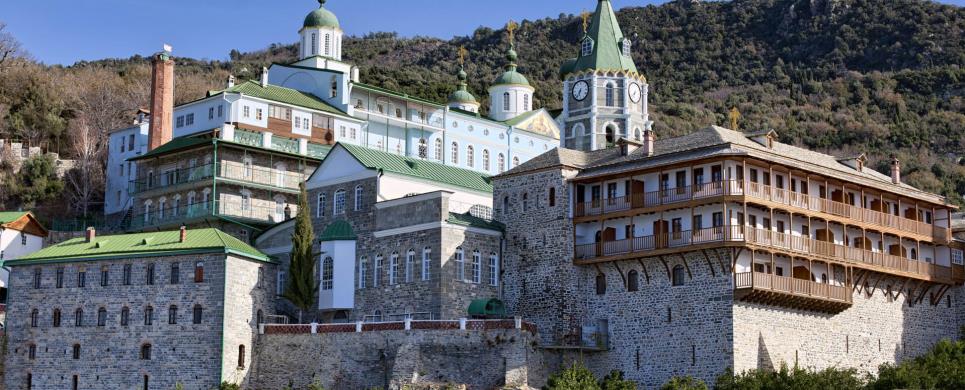
MONI AGIOU PANTELEIMONOS (Monastery) AGION OROS
Tel: +30 23770 23252, 23201
The monastery is built in a bay near the Xenophontos monastery, from
the side of Siggitikos and is dedicated to its namesake Saint. It gives the impression
of a small city with its many-stored buildings and the churches' tall cupolas.
The Katholicon is built in the early 19th c. and its frescoes are typical of the
russian art. The monastery has 15 chapels and 5 kellia, 2 of them at Karyes. The
monastery also owns the Chromitsa metochion, the Bogoroditsa (or the Carpenter's)
Skete, the Nea Thebais or Gournoskete and Paleomonastiro.
In the 13th c. the monastery is burnt and rebuilt with the financial
support of the emperor Andronicus II Paleologus and Serbian rulers. The monastery
knows alternatively periods of prosperity and great misery. The monks are Greek
and Russian, which outnumber the first after 1497. In the 18th c. the monastery
is again in greek hands, only to fall back to the Russians in 1875.
In the monastery there are many portable icons, heirlooms and liturgical
vestments. The library contains 1320 greek and 600 slavic manuscripts and over
20,000 greek and russian books.
The monastery in inhabited by a brotherhood of 40 monks.
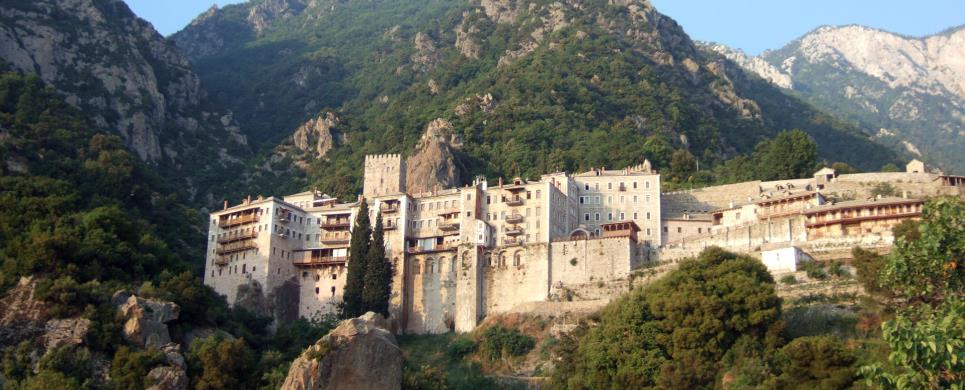
MONI AGIOU PAVLOU (Monastery) AGION OROS
Tel: +30 23770 23250, 23609, 23741-4, 23355
Fax: +30 23770 23355
It is situated in the west foot of Athos, 20 min from the sea and
is dedicated in the Presentation of Christ to the temple. The monastery was destroyed
many times by various causes, and its buildings belong to different periods. The
Katholicon was built shortly before the mid 10th c. The monastery has 12 chapels,
the most important of which is that of St George, with frescoes of the Cretan
School (1555). The monastery also possesses the Nea Skete and the Skete of St
Demetrius.
The monastery is mentioned for the first time, in the mid 10th c.,
mostly its founder Pavlos Xeropotaminos, and then in 1259. After the Catalan raids,
it is degraded into a kellion, only to become a monastery again in the 3rd quarter
of the 14th c. In the 15th c. it is financially supported by Serbians rulers and
after the fall of Byzantium, by rulers of eastern Europe.
Among the monastery's possessions, are counted portable icons, heirlooms,
holy relics and liturgical vessels.
The library contains 494 manuscripts and about 12,500 books.
The monastery is inhabited by a brotherhood of 30 monks.
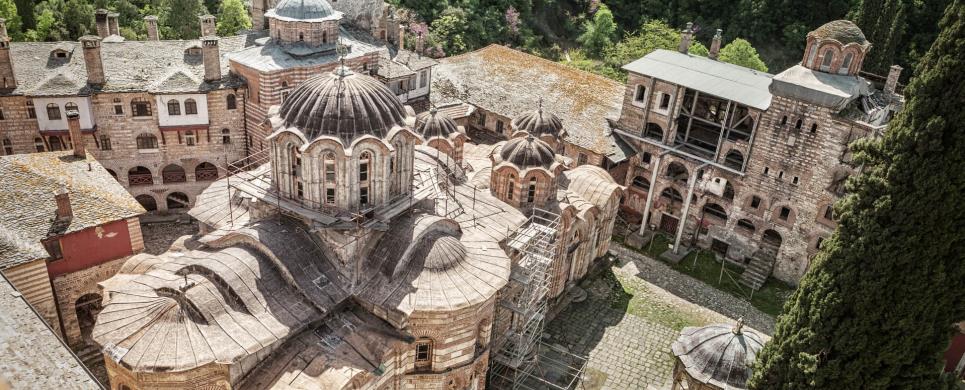
MONI CHELANDARIOU (Monastery) AGION OROS
Tel: +30 23770 23281, 23797, 23494, 23108
Fax: +30 23770 23494
The history of the monastery begins in the 10th century but, after
its ruin, the emperor Alexius III, in 1198 granted it to the Serbian rulers Stefan
Nemanja and his son Rastko, who became monks (Symeon and Sava respectively) who
proseeded to the construction of new buildings. During the 14th century, the monastery
reached its highest peak, accumulating riches and heirlooms from imperial as well
as private donnations.
One of the largest and richest in heirlooms monasteries of the Holy
Mountain, Chelandar is the main spiritual center of the Serbs from the 12th century
onwards. Besides the central church (Katholicon), honoured in the memory of the
Presentation of the Virgin, there are many chapels, the refectory and the aisles
with the monks΄ cells as well as the other auxiliary buildings (guest-house, library
and others).
The present monastic community preserves close relations with the
Serbian people as well as the Greek population of the Holy Mountain and its neighbouring
area.
Apart from the abundance of frescoes (St. George΄s Tower, Katholicon,
old and new Refectory etc), the monastery possesses one of the largest libraries
of Slavonic and Greek manuscripts, as well as a large number of portable icons
dated in the 12th century onwards.
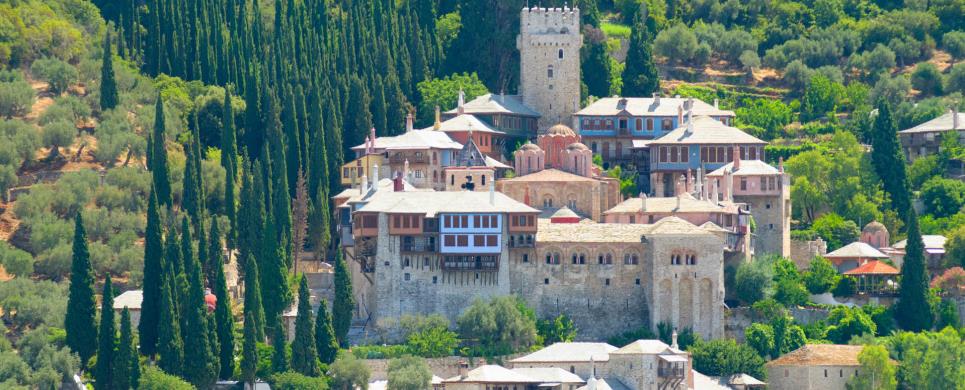
MONI DOCHIARIOU (Monastery) AGION OROS
Tel: +30 23770 23245
It is one of the most elegant and beautiful monasteries of the Holy Mountain, sited by the sea. One sees first the Refectoty (old and new) and ends at the uppermost
point on a high tower which dominates the place. The Katholikon, which is equally
high, has been built over the walls of the older church.
The monastery was founded during the second half of the 10th century;
its foundation is attributed to Euthymios, a pupil of Saint Athanasius of the
Great Lavra, who had the service of the "Docheion" (vessel), which gave the name
to the monastery. The Katholicon and the Refectory were built and decorated with
frescoes in the mid 16th century (1568). The wall-paintings of the Refectory are
dated in 1675 and in 1700 (the northern part).
Apart from the 16th century frescoes in the Katholicon, there are
also important frescoes of the 18th century in the exonarthex, which are excellent
copy of the 14th century from other monuments. Equally remarkable is also the
library of the monastery, where one can find, apart from the most important historic
monuments, abour 900 manuscripts.
The monastery is inhabited by a very active group of monks who take
care of its various needs -especially the hospitality to pilgrims and scholars.
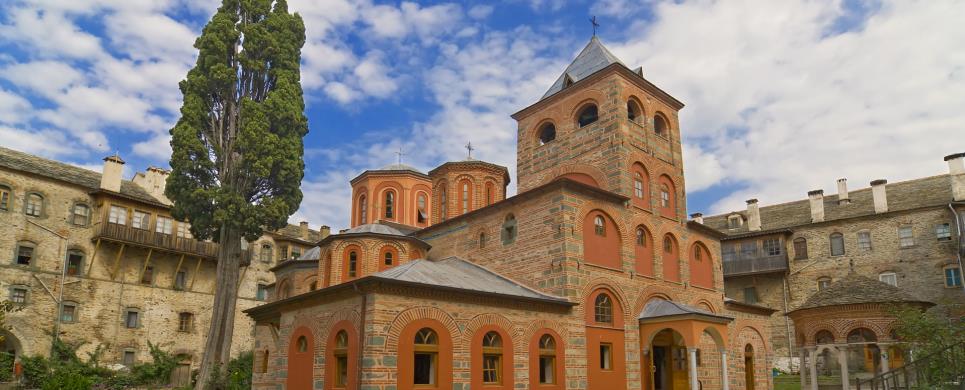
MONI FILOTHEOU (Monastery) AGION OROS
Tel: +30 23770 23256, 23674-9
Fax: +30 23770 23674
The monastery lies in a paltean, a little above the monastery of Karakallou
about 2.5 hrs from Karyes and is dedicated to the Annunciation of the Virgin.
The Katholicon is built shortly before the mid 18th c. and decorated with frescoes
after the mid 18th c. The monastery has eight chapels and 13 kellia, one of them
at Karyes.
The monastery was founded in the last quarter of the 10th c. but only
in the end of the 11th c. takes the form of a monastery. In the end of 13th and
14th c. the monastery receives financial aid by the emperors of Byzantium and
the Serbian rulers. After the fall of the empire, the monastery is financially
supported by the rulers of eastern Europe. In 1871, the monastery with the exception
of the Katholikon, the Refectory and the library, is burnt to the ground.
The monastery owns many heirlooms, holy relics and above all the miraculous
icon of the Virgin Glykophilousa. The library contains 250 manuscripts and many
books.
The monastery is inhabited by a brotherhood of 50 monks.
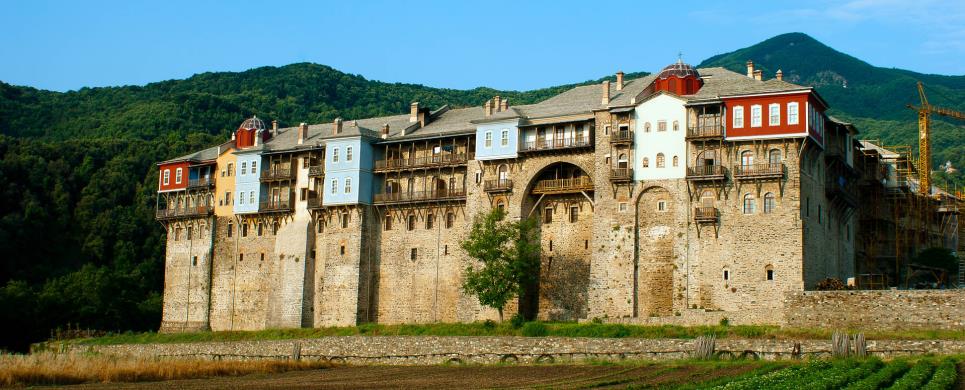
MONI IVIRON (Monastery) AGION OROS
Tel: +30 23770 23248, 23643-5, 23203
Fax: +30 23770 23248
Third in precedence among the twenty monasteries of the Holy Mountain,
the monastery was built in the end of the 10th century by the Georgian (Iberes)
monks Ioannis and Euthymius in the place where there was before the monastery
of Clement. The 16th century has been a period of prosperity for the monastery,
and, as result, it has been decorated with splendid painting works (the Katholicon
frescoes etc).
Built by the sea, the monastery is surrounded by four aisles, presenting
a rectangular shape. In the center, one sees the central church, founded in the
10th century, as the two historically important chapels, of Panaghia Portaitissa
and of John the Precursor. The largest part of the aisles has been rebuilt during
the 19th century.
A numerous monastic community is in charge of the restoration of the
ruined buildings surrounding the monastery and offers hospitality to scientists
from all the world, who wish to study the historic heirlooms of the monastery.
The monastery΄s feast is on August 15th - day of the dormition of
the Virgin - (August 28th in the New diary) and is celebrated with particular
splendour. Many pilgrims visit the monastery for the legendary miracles of the
Panaghia Portaitissa.
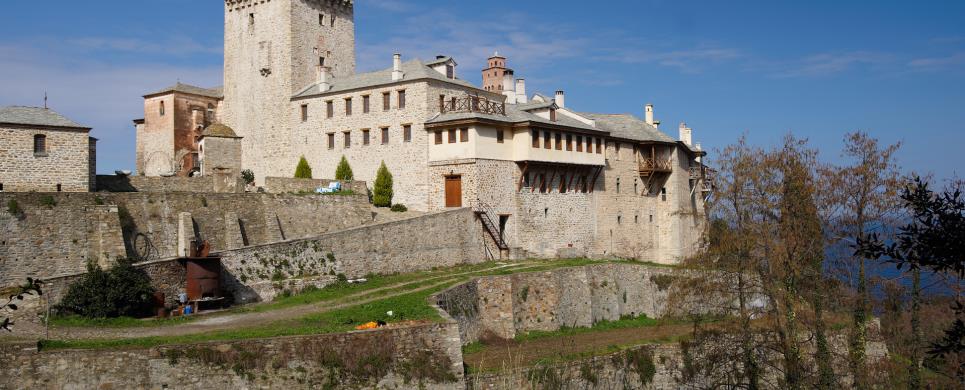
MONI KARAKALOU (Monastery) AGION OROS
Tel: +30 23770 23225, 23279
Fax: +30 23770 23746
The monastery is situated between the monasteries of Great Lavra and
Iviron, on a slope by the sea and is dedicated to St Peter and St Paul. Inside
the fortified enclosure, there is the Katholikon of athonite type, built in mid
16th c. and decorated with frescoes in the early 18th c. The monastery has 7 chapels,
4 Kellia in Karyes, and 14 Kellia in the forest to the S.W. of it.
The monastery is mentioned in documents of 1018 and 1087. In the 13th
c. the monastery is entirely ruined and rebuilt by the emperors Andronic II and
Ioannis V Paleologos. Afterwards the monastery is attacked by Latins and pirates.
In the 16th c. it is completely destroyed and rebuilt with the financial aid of
rulers of Moldavia and Vlachia.
In the monastery, there are many portable icons, holy heirlooms and
ecclesiastical vessels. The library contains 279 manuscripts and about 2,500 books.
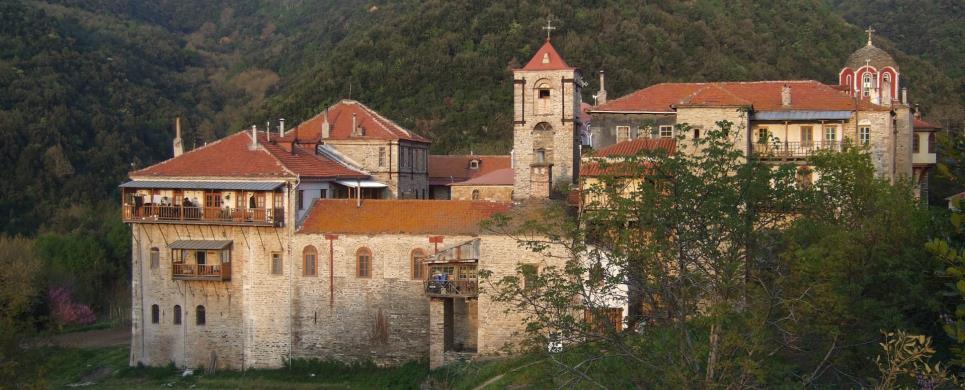
MONI KONSTAMONITOU (Monastery) AGION OROS
Tel: +30 23770 23228, 23278
The monastery is situated between the monasteries of Zografou and Dionysiou,
30 min from the sea, in the side of Siggitikos and is dedicated to St Stephen.
The Katholicon is built after the mid 19th c. following the athonite type, over
the ruins of the old Katholicon. The monastery has 9 chapels.
The first mention of the monastery is from the 11th c. In the early
14th c. it is destroyed. Afterwards, its borders are defined by imperial chrysoboula,
and it is financially supported by Serbian rulers. After the fall of the Empire,
the monastery knows alternatively periods of prosperity and great
Perhaps, the most outstanding of the monastery's heirlooms, are the
portable icons of St Stephen, of Virgin Hodegetria and of Virgin Antiphonetria.
There are also reliquaries, ecclesiastical vessels, chrysoboula and others. The
library contains 110 manuscripts and many books.
The monastery is inhabited by a brotherhood of 30 monks.
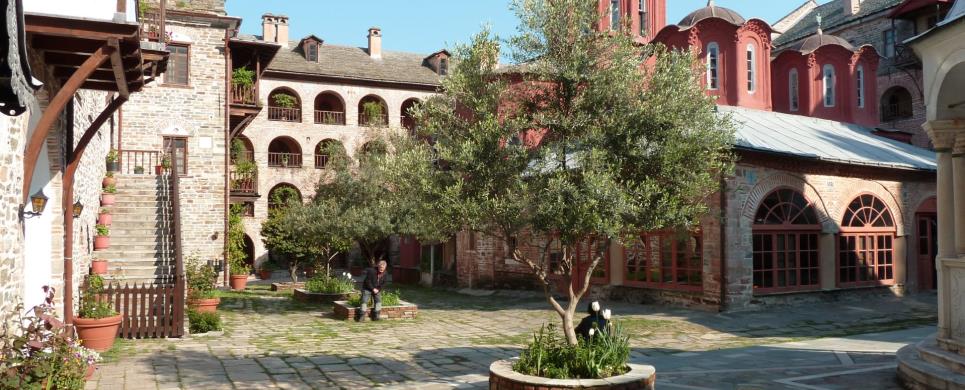
MONI KOUTLOUMOUSSIOU (Monastery) AGION OROS
Tel: +30 23770 23226
Fax: +30 23770 23731
The monastery buildings are set in a rectangular shape with a rather
vast courtyard, with the central church (Katholicon) in its center. The refectory
is presently built a new (1995), while the central church, built in the 16th century,
is covered with five domes and with a glass covered exonarthex.
The original monastery was built before the 12th century but in the
14th centutry, abbot Chariton of Imvros, receeded to the enlargement of the monastery;
during its lifetime vast destructions were caused either by fire or by fall of
rocks.
Apart from the Katholicon frescoes dated in the mid 16th century,
the monastery possesses more than 600 manuscipts, many of which are illuminated,
as well as imporant historic archive and a large number of old printed books.
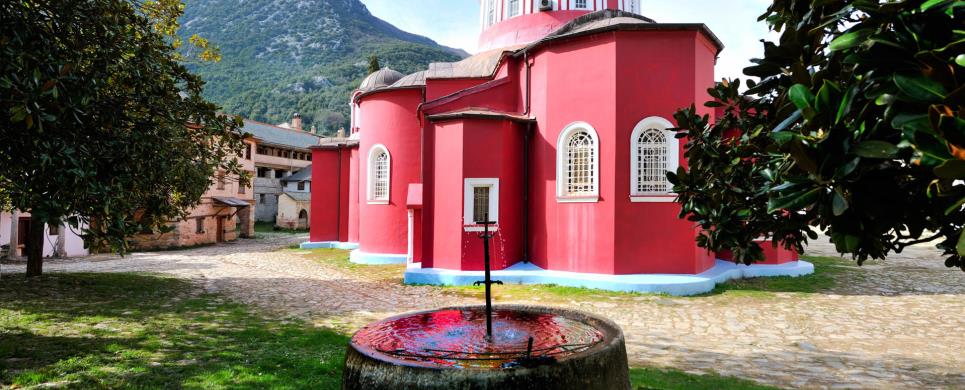
MONI MEGISTIS LAVRAS (Monastery) AGION OROS
Tel: +30 23770 23761, 23277
Fax: +30 23770 23762
It was built in 963 by St. Athanasius the Athonite, with the financial support of the emperors Nikephorus Phocas and Ioannis Tzimiskes. During the ten centuries of its existence, the monastery has always held the first place among the other monasteries of the Holy Mountain, partly because of its wealth, partly because of the heirlooms stored there (manuscripts, historic documents, chrysobulls, portable icons etc).
The monumental structure of the
monastery complex
is particularly noticed in its
large buildings.
The central church (the Katholicon)
with the two large chapels of the Forty Martyrs and of St. Nicholas, occupies the center of the monastery. Within the enclosure, there is also the refectory, the kitchen, the library etc. In the four aisles, which surround the monastery, are the monks cells, the guest-house,
chapels and others.
The monastery is inhabited by 50 monks whose daily occupations are
divided among their monastic duties (mass,prayers etc.) and the hospitality to
the many visitors from all the world.
The monastery remains open throughout the year from sunrise until sunset. During the winter months, it is extremely difficult to reach the monastery. The visitors who wish to study or take photographs of the monastery΄s works of art, must first contact the 10th Ephorate of Byzantine Antiquities as well as the monastery itself.
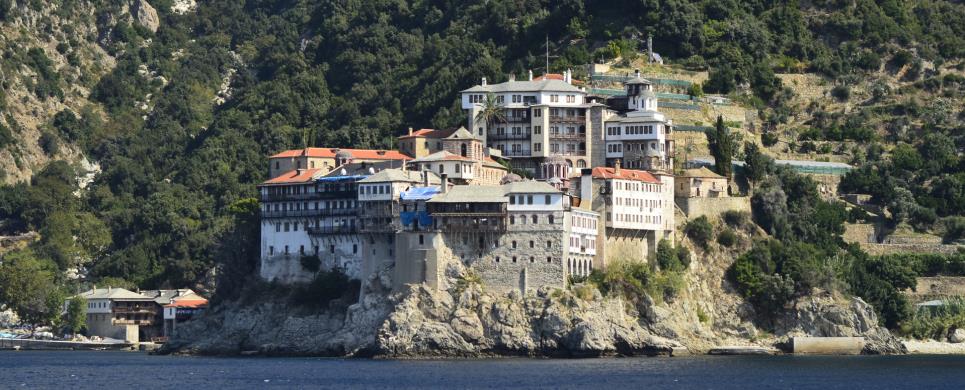
MONI OSSIOU GRIGORIOU (Monastery) AGION OROS
Tel: +30 23770 23218, 23669
Fax: +30 23770 23671
The monastery is built by the sea, in the S.W. side of the peninsula,
between the monasteries of Dionysiou and Simonopetra and is dedicated to St Nicholas.
The Katholicon is built and painted after the mid 18th c. The monastery has 10
chapels and 4 kellia in Karyes.
The monastery is built during the 14th c Afterwards, there is very
little information of it. The Russian pilgrims Barsky (18th c.) reports that the
monastery was restarted in 1500, is the smallest of the monasteries, and almost
all the heirlooms and the documents were lost in the fire of 1761. The monastery
is finally rebuilt with the financial aid of the princes of Moldavia and Valachia.
Inside the Katholicon are kept many heirlooms and portable icons,
the most outstanding of which are those of St Nicholas, of Virgin Galaktotropousa
and of Virgin Pantanassa.
In the library there are 297 manuscripts, about 4,000 books and many
documents.
The monastery is inhabited by a brotherhood of 70 monks.
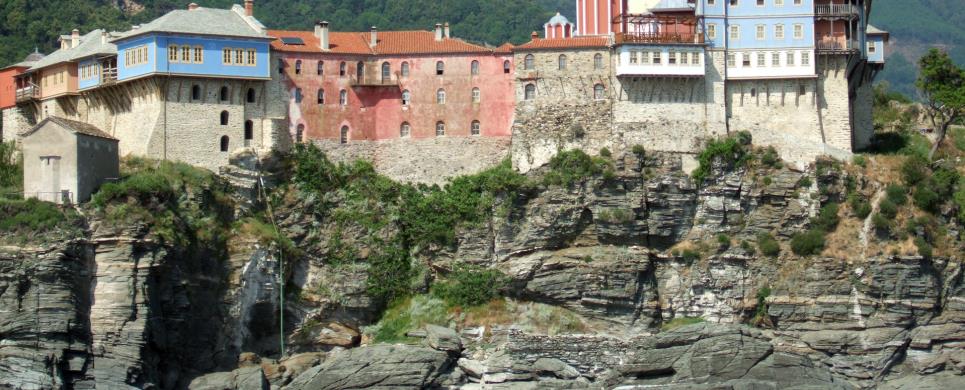
MONI PANTOKRATOROS (Monastery) AGION OROS
Tel: +30 23770 23253, 23685, 23880
Fax: +30 23770 23685
The monastery is built by the sea, in the N.E. side of the peninsula
and is dedicated to the Transfiguration of the Saviour. The Katholicon follows
the athonite type and has frescoes of the 14th c. that were painted over in 1845.
The monastery has 15 chapels, the most important of which is that of the Dormition
of Virgin. Among the Kellia of the monastery, the most important are of the Ravdouchou,
possibly of the 10th c. and the Dormition of the Virgin, named Axion Esti after
the namesake icon. The Skete of Prophet Elias belongs also to the monastery.
The monastery's founders were two byzantine officials, Alexios and
Ioannis, who in mid 14th c. with the support of the emperor Ioannis 5th Paleologus,
transformed their cell into a monastery. After the fall of the empire, the monastery
is financially supported by rulers of eastern Europe. Two destructive fires took
place in 1773 and recently in 1948.
The monastery possesses a large collection of portable icons, ecclesiastical
vessels and heirlooms, while in the library there are 350 manuscripts and over
3,500 books.
The monastery is inhabited by a brotherhood of 25 monks.
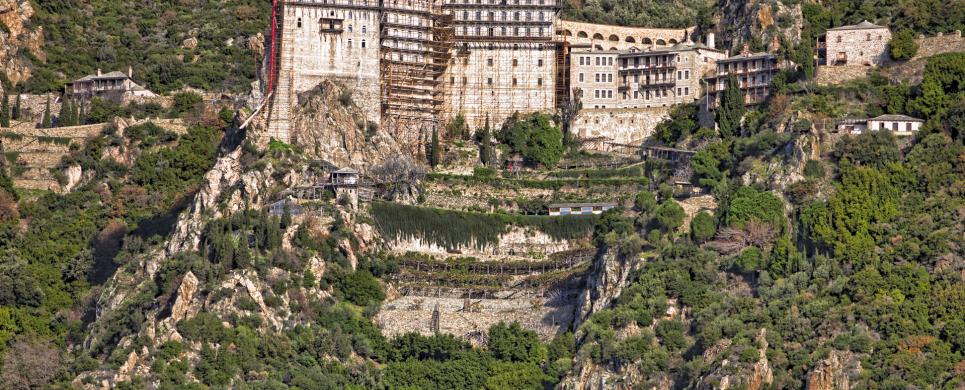
MONI SIMONOS PETRAS (Monastery) AGION OROS
Tel: +30 23770 23254
Fax: +30 23770 21014
The seven-stored monastery of Simonopetra is the most bold construction
of the peninsula, and is dedicated to the birth of Christ. The name comes from
the founder of the monastery, Hosios Simon, who lived in Athos in the mid 14th
c.The Katholicon was built after the last fire and has no frescoes. The monastery
has 15 chapels and 5 Kellia in Karyes.
At the end of 16th c. the monastery is burnt down, rebuilt and reburnt
in the beginning of the 17th c. This long period of decline is interrupted by
shorts periods of prosperity. At the end of the last century, the monastery is
one more time burnt, and rebuilt with funds from Russia.
Among the monastery's heirlooms, the most important is a piece of
Saviour's Cross, holy reliquaries and others. The library, after the last fire,
possesses only a few modern manuscripts and books.
The monastery is inhabited by a brotherhood of 60 monks.
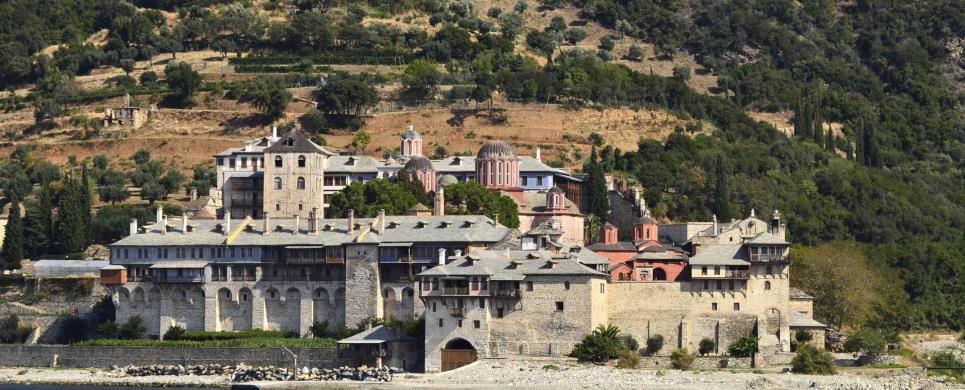
MONI XENOFONTOS (Monastery) AGION OROS
Tel: +30 23770 23249, 23633
Fax: +30 23770 23631
It is built by the sea, between the monasteries of Docheiariou
and St Panteleimonos,
and is dedicated to St George. The Katholicon is built in the early 18th c. and
has no frescoes. In the old Katholicon, there are remarkable frescoes of the Cretan
painter Antonius (1544) as well as the wooden-curved templum of the 17th c. The
monastery possesses 14 chapels, 8 of which are inside the monastery.
The monastery is mentioned for the first time in the last quarter
of the 11th c. Its period of prosperity is interrupted by the fall of Constantinople.
Afterwards, the monastery is alternatively destroyed and rebuilt with the financial
aid from the rulers of eastern Europe.
Among the heirlooms of the monastery, the most prized are the two
mosaic icons with the Transfiguration of Christ, ecclesiastical vessels and others.
In the library there are 300 manuscripts, various documents and over 4,000 books.
The monastery is inhabited by a brotherhood of 35 monks.
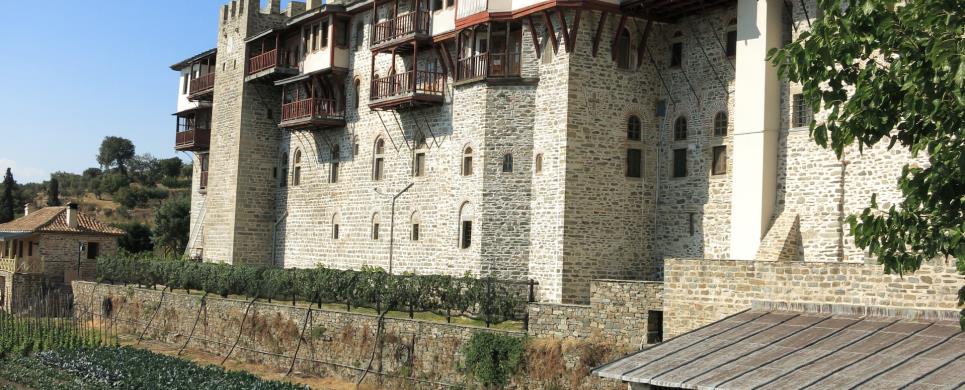
MONI XIROPOTAMOU (Monastery) AGION OROS
Tel: +30 23770 23251, 23733
Fax: +30 23770 23733
The monastery is in the middle of the athonite peninsula, on the way
from Daphne to Karyes and is dedicated to the 40 Martyrs. The Katholicon was built
in 1761 by the monk Caesarius Daponte and decorated with frescoes in 1783. The
monastery has several chapels and a few kellia.
The monastery was founded in the end of 10th c., possibly by the monk
Pavlos Xeropotaminos, and prospered till the Frankish conquest, when it is attacked
and sacked by pirates. In the late Byzantine period it is financially supported
by the Paleologan dynasty as well as Serbian rulers. After the fall of Byzantium,
the turkish raids, and two destructive fires in 1507 and 1609, cause serious damages
to the monastery.
The monastery owns a rich collection of heirlooms, the most outstanding
of which, is the largest in the world piece of the Christ's Cross, as well as
a small round steatite icon, known as the Pulcheria Disk.
The library contains about 400 manuscripts and 4,000 books.
The monastery is inhabited by a brotherhood of 30 monks.
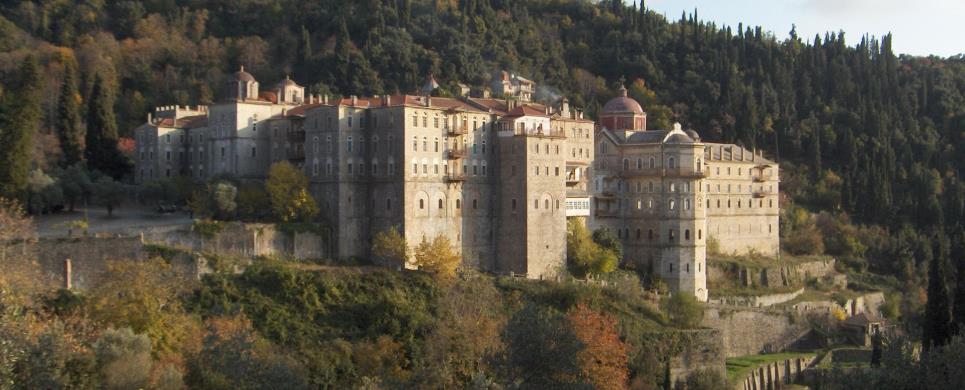
MONI ZOGRAFOU (Monastery) AGION OROS
Tel: +30 23770 23273, 23247
The monastery is situated on a slope of the S.W. part of the peninsula
and is dedicated to St George. The Katholicon was built in the beginning of the
last century and follows the athonite type. The monastery has eight chapels inside
and eight chapels outside of it. The monastery also owns two workshops in Karyes
and the Kelliou of Transfiguration.
The monastery was founded, according to tradition, in the 10th c.
by three brothers, Moses, Aaron and Ioannis from Achris. In the Late Byzantine
period, the monastery is destroyed by Catalan pirates and rebuilt with the financial
support of the Paleologan dynasty, as well as that of rulers of eastern Europe.
Initially, the monastery was inhabited by Bulgarians, Greeks and Serbs. Since
1845 there are only Bulgarian monks.
Besides two miraculous icons of St George and other two of the Virgin
of the Akathistos and the Virgin Epakouousa, the monastery owns and other heirlooms
and ecclesiastical vessels.
The library contains 126 greek and 388 slavic manuscripts, and over
8,000 books.
NEA MOUDANIA (Small town) HALKIDIKI
Today, Nea Moudania is a town inhabited by 6537 people. It is the
seat of the Municipality of Moudania as well as the main commercial, financial
and intellectual centre of Halkidiki. The town has an intense tourist and financial
development, and is likely to become the educational centre of Halkidiki, as there
is a Τ.Ε.Ι. (Technical Education Institute) college operating there too.
Nea Moudania is situated at a distance of 60 km from the city of Thessaloniki
and is linked to it by a comfortable motorway, which goes through vineyards and
hillocks. The Halkidiki coach company, KTEL (Single Bus Exploitation Fund) offers
regular services (every quarter of an hour) linking Nea Moudania with Thessaloniki
and the rest of Halkidiki. ”Macedonia“ airport is only 35 km away
from the town.
On the outskirts of Nea Moudania, there is a vast olive plantation,
a landmark which in 1923 was one of the attractions for the pioneer settlers of
the town.
Having passed the olive plantation, one can revel in the marvellous
vastness of the sea, which looks ready to take the visitor in her bosom. The depth
of the waters is ideal for the little visitors, as well as for those who are not
particularly good swimmers.
At the beach of Nea Moudania you can enjoy your coffee, and the very
fresh fish and also the ouzo titbits offered at the fish-houses.In the summer
the town has also a cinema.The visitor can have unforgettable moments at the various
town bars and clubs.
At the highest point of the town, called ”the hillock of Panagia
(Virgin Mary) Koryfini“ there is a pretty three-aisled basilica church,
built in a captivating environment. The icon of Panagia Koryfini, which came from
Kalolimnos of Asia Minor, is kept there. The Virgin is commemorated with splendid
celebrations on 8th September, which is a local public holiday.
The sunset behind Mount Olympus from the numerous cafes in central
Nea Moudania is a superb view to please every romantic visitor. Moreover, when
the weather permits, the visitor can be photographed against the background of
the Kassandra peninsula.
At the Open-air Theatre, the jewel of the town, with a capacity of
2000, quality theatre productions and high-class concerts are hosted as part of
the events of the ”Sea Festival“ right next to the waterfront, throughout
summer. The festival is certain to monopolize your interest at summer nights.
Nea Moudania also has an important museum of marine exhibits and seashells, which
is unique in Greece, as well as a folklore museum with exhibits from the inhabitants'
never-forgotten homelands.
In mid-July the cultural club ”Faros“, under the auspices
of the Municipality of Moudania, offers the locals and the visitors of the town
times full of entertainment and thrill in a week of folklore, which also includes
dance, music and theatre events peaking on Sunday with the ”Sardine festival“,
a feast marked by the smell of grilled sardine and retsina, which are offered
generously to all.
After a Thessaloniki Τ.Ε.Ι. (Technical Education Institute) college
branch was formed in the Municipality, all tiers of education are available, i.e.,
creches and day nurseries, Preschools, Primary Schools, Secondary Schools, TEE
(technical high school), Senior High School, IEK (vocational high school), Conservatoires,
etc.
The indoor gymnasium, football pitches with sod, of the classic type
(5X5) and also other sports grounds, such as basketball, volleyball and tennis
courts encouraged the development of basketball, volleyball and football teams
which progressed into top league divisions.
Every year, beach soccer, beach volleyball, and beach tennis matches
are organized, with entries from all over Greece.
The Yachting Club of Nea Moudania, with its numerous activities, has
often gained international distinction for its sailing courses and in international
fishing competitions.
In Nea Moudania there is a Health Centre, a great number of private
surgeries and laboratories of almost every specialization. There are chemist's
shops that stay open twenty-four hours a day as well as a public veterinary hospital
and four surgeries for pets.
A new deluxe hotel unit with a state-of-the-art conference centre
and a spa section will soon start operating in the town.
Seeing that Nea Moudania boasts of one of the largest fish-wharves
in Greece, the fish catch of the town is considerable.
The cultivated land area is 110,000,000 sq. metres, yielding considerable
quantities of olives, peanuts, apricots etc. Olive presses and olive, salted preserves
and fruit packing factories cater for the needs of the consumers. These products
are also exported to many other countries.
The town of Nea Moudania, the centre of the Municipality, is the commercial
centre of Halkidiki par excellence. There are Agricultural Bank, National Bank,
Commercial, Piraeus and ALPHA bank branches, where there are automatic transaction
machines. Big supermarkets and many good commercial shops cater for consumer needs.
Every Wednesday, the biggest outdoors market in Halkidiki takes place. There are
also agricultural machinery factories and other manufactures.
Tickets for excursions to the Sporades islands on small ferries and
”dolphin“ ferries or for a tour around Mount Athos are also available
at the Post Office and on-line bureaux.
Nea Moudania was founded in 1923 by refugees of the areas of Moudania,
Kios, Kalolimnos, Sigi, Eligmoi and the surrounding area of Proussa. The victims
of the Asia Minor tragedy were faced with huge problems, mostly survival problems.
The situation was desperate, as there was not an inhabited area around. The place
mainly consisted of fields of the neighbouring villages, while the remaining parts
were swamps, a breeding ground of bacteria. The only inhabitants were some fishermen
and the olive plantation guard.
The area was called ”Kargi Limani“, which in Turkish means
”leeward harbour“ and was marked with an anchor on nautical maps,
just like Moudania of Vithynia, where the refugees came from. In 1925, this name
was replaced by ”Nea Moudania“.
In August 1923 the first refugees arrived and tried to start anew
in a place far from home.
They opted for this area thanks to the immense olive plantation which
is still there, to the west of the town, and the red rocks to the east. The help
offered by the Reverend Saint of Kampania, Mr Diodoros, then president of the
Committee for the Settlement of Refugees was substantial.
The following extract from the book by Stavros Kouvrakis ”Nea
Moudania“ gives an expressive account of the situation:
”One spring morning of 1923 Zafiris Zafiriou and an American
friend of his got into a motorboat named ”Dolphin“ and pushed out.
They were travelling eastwards along the coast of Halkidiki. It was dark, when
they reached the shore of Epanomi. There was not a soul in sight. Only the village,
at a distance of four kilometres from the shore. They spent the night on the beach
and in the morning they pushed out again. Night was getting near, when they got
to a place about four miles away from Kassandra. They turned off the motor immediately.
That they did, seeing that they had found what they had been looking for in the
surrounding area. A range of hillocks, in horseshoe shape, with the left side
planted with olive trees with leaves glistening in the setting sun as they were
stirred by the light land breeze, filled them with enthusiasm. Everybody knew
about the cultivation of olive trees, as this blessed tree thrived everywhere
on the coast of Asia Minor. In the distance, vast fields, suitable for vineyards,
orchards, and granaries. Before them a small bay, with small vessels and two or
three buildings. That was it. They made their decision on the spot“
Bibliography. ”Echoes from Moudania and the surrounding area“, distributed
by the Municipality of Moudania.
NEA PLAGIA (Small town) HALKIDIKI
Tel: +30 23730 31204
Fax: +30 23730 31111
NEA POTIDEA (Small town) HALKIDIKI
Tel: +30 23730 41563
Fax: +30 23730 41340
Νea Potidaia is the only point of access to the Kassandra Peninsula.
Its enchanting canal is one of its most unforgettable sights. Boats
cross its waters on an everyday basis, including boats with acetylene lamps and
dragnet boats, which fill up with a profusion of fish.
There are 1601 permanent inhabitants in the village, who in the summer
go up to a few thousand.
At the organized, exquisite beach
of Nea Potidea, one can enjoy the sea and savour plenty of fish, in one of
the numerous fish-houses of the area.
On the village's hill, there is the picturesque church of the Virgin
Mary who celebrates on the 23rd of August.
Nea Potidea was built in 1923 by refugees of Eastern Thrace and Kololimnos,
on the ruins of the ancient city of Potidea.
Ancient Potidea was founded in 600 BC on the saddle of the Pallini
Peninsula.
As the name of the city denotes, its patron was Poseidon. During the
expedition of Xerxes against Greece in 480 BC, the city was defeated following
a siege. However, a year later it gathered forces and resisted the siege of Artavazos.
In the same year, it was the only city of Macedonia which, along with other Greek
cities, took part in the battle of Platees.
Its history goes back a long way in the depths of the centuries. Potidea
was a member of the first Alliance between Athens and Delos. It seceded from the
alliance in 432/1 BC with the support of the Corinthians and King Perdikas II.
In 431 BC, after the siege by the Athenian general Kallias, it was subjugated
and subsequently forced to take in settlers from Athens. When the Peloponnesian
war was over, Potidea was freed from the domination of Athens and received a second
wave of Athenian settlers in 362/1 BC. In 356 BC, it was ruined by the king of
Macedonia, Philip II and was turned over to the Olynthians.
In 349/8 BC the city had the fate of the other cities of Halkidiki,
that is, it became part of the Macedonian Kingdom.
After a period of desertion of about 40 years, in 316 BC, Kassandros
built on the site of Potidea a new city, which was named after him, Kassandria.
In the following period until the taking of Macedonia by the Romans (168 BC),
Kassandria developed into one of the most powerful cities of Macedonia. It was
almost certainly during this time that the canal was opened up, which facilitated
navigation and boosted trade and economic development.
In 168 BC, the city came under Roman rule and flourished a new.
Potidea's decay is linked to the invasions of the Huns, who invaded
Macedonia in 540 BC. Consequently, despite Justinian's efforts in the 14th century
AD, the city was completely deserted, according to historical sources. Its castle,
being of great importance for the security of the whole peninsula, was repaired
by Ioannis VII, Paleologos, in 1407 and later by the Venetians. In 1430 it came
under Turkish domination.
With the Greek Revolution of 1821, the old fortification was repaired
and reused, while in the same period the new cutting of the canal was made.
In 1821, the revolting people of Halkidiki entrenched themselves in
the castle. They fought hard until the ”turmoil of Kassandra“, the
well-known ”holocaust“ which is commemorated with big official celebrations
every year on its anniversary, November 14th.
NEA RODA (Village) HALKIDIKI
Tel: +30 23770 31023
Fax: +30 23770 31203
Nea Roda is the biggest refugee village in northern Halkidiki. It
was founded immediately after the Asia Minor destruction in a place called "Provlakas"
(= before the avlaki = before Xerxe's Canal ) by roughly 40 refugee families which,
after a year of roaming, reached Halkidiki in the summer of 23' and came to this
area.
They came from Roda in the area of Propontida
near the Marmara Sea or "Sea of the Greek spirit". In 1901, about 700 Greek people
lived in the village. According to tradition they were settlers from Roda. In
the village at that time there were also about 100 Turks living here, who had
come from Koutali in 1700, by a Turkish order.
The whole area but also the wider region is presented as paradise:
Rich sea and fertile soil. They produced silk from silkworm cocoons, granite in
blocks, fish, fruit, olives, grapes, onions and a lot of other products,which
they promoted with boats to Istambul.
They had three churches (biggest being the church of Saint Dimitris) and an upgraded
level of school. Up to 1912 they lived happily. Then things started to change
when new Turks arrived. In all the Greek Asia Minor villages, the fear of slaughter
and exile prevailed, with the known conclusion of that black August in 1922. The
people of Roda fled in two different ways : Two boats left for Mitilini,
while most pass over to the island of Aloni and afterwards over to the island
of Marmaras. After 20 days the ship called Propontis picked them up and took them
over to an area in Thessaloniki called Karabournaki, in order to end up in an
area called Saint Barbara in Ano Toumba.There
they scattered in small teams.
In 1923 the team in Mitilini is the one that reached this region first,
rejecting the place of current Ouranoupolis considering it small and narrow so
it resided for a few months off-handedly in Ierissos. There they proposed for
their new village to be established after the harbour of Ierissos, but the locals
were opposed to this in fear of future union. So they finally selected the place
"Provlakas" and gave it the obvious name "Nea Roda".
The new village began to attract more refugees. A signifant number
of them reached in privately-owned boats from Skopia ( or Skoupia), an area on
the island of Aloni, opposite and very near Roda. The residents were mainly seamen
and tradesmen. Religious as they were, they first took with them the miraculous
icon of the Virgin Mary, who today is the protectress and pride of Nea Roda. Families
from Eastern Thrace, but also from Haraki and Gonia of Kizikou also arrived. In
the meantime the other people of Roda residing elsewhere were informed of this
new found land and most of them, correspond to the call, and also come to Nea
Roda.
On the 14th of June in 1924 the exchange of populations began. The
last Greeks of Asia Minor were eradicated and entered Greece seeking a new homeland.
A big team from Kappadokia
in 1926 arrived in Nea Roda, and the village takes its final form. Antaval ( "Antavali's"
or "Antivalon") from the region of Nigdis in Kappadokia, was the homeland of this
team. The new village although turkish spoken, is completely greek with approx
1800 residents. The church of Saint Konstantine was built in the year 500 A.C.
and its ruins are preserved up to today. The name of the village emanates very
probably from the verb "antivallo" (= I oppose), because of the permanent litigation
with the turks. A place rocky, poor and barren, with marginal production, often
led the men for periodical work to Istamboul. Specifically in 1913-1923 they suffered
from Turkish pillages and lived in fear for their lives. When the command of abandonment
was given, with head leader their priest Agathaggelo, they left on their horsewagons
for Nigdi-Oulougousla and down to Mersina. After 1-2 months travelling north,
they reached the area of Saint George in Piraeus
and after Thessaloniki.
From there, a big part passed from Pirgadikia, Ouranoupolis and Orfani but due
to malaria and misfortunes they finally reached this region. For roughly 5 years
they resided in the surrounding area, and then, with the little help of the greek
government, they installed themselves and gave the village its current form.
Difficult years followed for all the residents. The nostalgia for
the homelands was expressed continuously with the wish "ante gia mas ke kali patrida!"
meaning 'to our health and a good return back to the homeland'. However there
was also the will for a new start. They opened upto the sea, they cultivated the
ground, and slowly - slowly progressed considerably.
There are barely any representatives alive of first generation of
refugees that may recall any of this however the knowledge of our history, is
precious for us, the younger generation.
NEA SERMYLI (Settlement) HALKIDIKI
Nea Sermyli was built very recently. The citizens are scattered all
around the ruins of the ancient
Sermyli. It's 5 km away from Ormylia.
The settlement grows very fast because it is upon the junction of the local road
to Ormylia and the highway Thessaloniki
- Sithonia and because
of the installation of many commercial motions in the area. Due to those facts,
today there are 80 citizens in the settlement, while the National Population Counting
of 1991 had recorded 29 citizens.
This text is cited Oct 2003 from the Municipality of Ormylia URL below.
NEA SKIONI (Village) HALKIDIKI
Tel: +30 23740 71292
Fax: +30 23740 71600
The village of Nea
Skioni is built around its magnificent port.
The sun joins with the sea and a serene placidity is spread all around
as the fishing boats return from the sea loaded with fresh fish which you can
enjoy in the local tavernas.
NEA TENEDOS (Village) HALKIDIKI
Tel: +30 23730 53200
Fax: +30 23730 53201
NEA TRIGLIA (Small town) HALKIDIKI
NEOCHORI (Village) HALKIDIKI
Tel: +30 23720 41239
Fax: +30 23720 41874
NISSI (Settlement) HALKIDIKI
The settlement of Nisi, is at the centre of the coast area and it is a product
of the constant illegal building in the last years. It has a population of 60
citizens, by the sea.


OLYMPIADA (Village) HALKIDIKI
Tel: +30 23760 51275
Fax: +30 23760 51275
Olympiada is located on the N.E. side of Halkidiki, in the Strimoniko
gulf at a distance of 95 kilometres from Thessaloniki via Stavros
(80th kilometre on the National road Thessaloniki
- Kavala there is the
exit for Stavros).Olympiada is 12 kilometers away from Stavros.
Olympiada Today
Olympiada is a beautiful village of 700 residents, built along a sandy
beach which stretches out to the edge of a natural harbour and is surrounded by
evergreen mountains (the beach of Olympiada has been rewarded with the "blue
flag" continuously during the last years). Everything has blended in splendidly,
attracting visitors from all over Greece and abroad. It combines the atmosphere
of a village with the comfort of the modern world, offering a complete tourist
infrastructure. In the region there are 3 hotels with a capacity of 120 beds and
a lot of rooms to rent with a capacity of more than 400 beds.There are also 2
camps.
Olympiada offers to visitors who would like quiet holidays, a clean
sea, fishing, walks in the around area and in the Archaeological places, without
however missing something from night life for those who wish to combine both.
For those who have small children, Olympiada is the most suitable place for holidays
because the waters are shallow, hardly 30-50 cm depth for at least 50 metres distance
from the coast.
OLYNTHOS (Village) HALKIDIKI
Tel: +30 23730 91362
Fax: +30 23730 91362
ORMYLIA (Small town) HALKIDIKI
Ormylia is the primary settlement and the head of the municipality.
It is built on the northern area at the foothill of the mt. Holomontas. Its population
reaches the 3.500 persons and it's the third biggest settlement of the country.
The general urban design of Chalkidiki country suggests the preservation of the
architectural and town - planning elements of the settlement, considering also
the fact that this is what the citizens wish too. The oldest building in the settlement
is the central Church of St George (1818). Some newer ones that are still intact
are: the campanile, some country houses from the previous century and the old
public school of 1909 in a very good shape. That building also serves these days
as the town hall.
OURANOUPOLI (Village) HALKIDIKI
Tel: +30 23770 71216
Fax: +30 23770 71460
Ouranoupolis is the threshold of Mount
Athos. It is the last village just a kilometre before the border of the Holy
Mountain and where a visitor who intends to visit the monastic state must go to.
Every day, from the small harbour under the shade of the Tower, you will see the
boats which take the pilgrims (after they have previously aquired the visa pass
they will need to enter) to the Monastic Republic.
Ouranoupolis took its name from the Alexandrian city that was founded
in 315 B.C. by Alexarhos, the son of Antipatros and brother of Kassandros. This
city was built on top of the ruins of Sanis
an Andrian colony, which Phillipos the 2nd had previously destroyed from its foundations.
Ancient coins found bring the sign "Ouranio Poleos" meaning city in the sky and
it also had the representation of Ouranio Afrodite seated on a ball on one side
and on the other the sun shining with eight beams.
The first monasteries were founded in the 10th century on the peninsula
of Athos. One of these was also the "Abbey of Zigou" or "Fraggokastro" which was
discovered near Ouranoupolis. In this monastery, Osios Athanassios the Athonite
and founder of Megistis Lavras
practised for some time. This Abbey is still at the stage of excavation from which
important discoveries have been revealed and it possesses the important privilege
of being uniquely positioned outside of the border of Mount Athos, so consequently
it can be visited by women.
In the beginning of 14th century the Abbey
of Vatopedi built the Byzantine Tower that dominates untill today the S.W
end of the village for the protection of the metohi (property). This tower is
the biggest and the best maintained (particularly after its recent restoration
by the 10th Inland Revenue of Byzantine antiquities) in Halkidiki. An earthquake
in the 19th century which completely destroyed the top floor made repairing necessary
and so it then took on its final form. During the same time its accompanying buildings
were built. One of them accomodates nowadays the local municipal office.
After the Asia Minor destruction, refugees from the Marmara
islands in Propontida reached this area and found shelter in the Tower, its accompanying
buildings and in tents. In 1926 a German company built the first houses of the
village, some of which still stand today. Later the residents built the Church,
the School and so began the organised community with the name Prosforion. Later
the village took on the name Pirgos meaning "Tower" and in around 1960, it took
on its final name "Ouranoupolis". In 1928 the Lock couple from Australia came
to the village and connected themselves to the life of the village. They lived
in the tower and in collaboration with the residents who knew the art of carpet
making used drawings copied from monastic codes and put the foundations of a local
manufacture which gave work and income to a lot of families.
The first tourists arrived in the 60th decade . At that time roads
were built, streets in the village were finally completed and last but most important
electricity came. Also the first hotel was built and named Xenia.
Today Ouranoupolis is considered to be one of the most important resorts
in northern Halkidiki. There are many restaurants and Hotels that offer the visitor
good food and a comfortable stay. During the summer months there are daily cruises
to Mount Athos from the harbour of the village. A must for those who choose this
unique and beautiful village and a chance for one to see all the monasteries on
the western side of Athos. One may also enjoy the sea and the beautiful and clean
coasts or go opposite to the islands called Drenia.
For those who love nature, there are lots of walkingpaths through
the olive and pine hills. One may also visit the "Serbian" region on the Northern
side of the peninsula and ofcourse the "Zigou Abbey" just a kilometre
away from the village.
In the village one can visit the exhibition in the Byzantine tower
with Byzantine antiquities and icons. In the souvenir shops you may find famous
hand made carpets with Byzantine drawings, goat hair rugs,Byzantine icons or jewels
made with natural raw materials. You may also find local products such as oil,
wine, honey, raki (tsipouro), oregano and various teas. In the evenings you may
dine in one of the picturesque taverns,taste the fresh fish and enjoy carefree
moments. One might also be lucky and be in the area when cultural events and religious
holidays take place.
PALEOCHORI (Small town) HALKIDIKI
Tel: +30 23720 41209
Fax: +30 23720 41777
PALEOKASTRO (Village) HALKIDIKI
Tel: +30 23710 92360
Fax: +30 23710 92360
PALIOURI (Village) HALKIDIKI
Tel: +30 23740 92208
Fax: +30 23740 92028
Paliouri has a
unique natural beauty.
You can stroll around the wooded mountain paths or in the old narrow
paths of the village which form a unique traditional colour.
Look for the busy Chrousi
beach but also for the remote smaller beaches.
PEFKOCHORI (Port) HALKIDIKI
Tel: +30 23740 61211
Fax: +30 23740 61059
The modern developed and busy beach of Pefkohori
offers numerous moments of delight.
Feel the velvet sand and dive in the crystal clear blue sea.
The intense night life and the strolls on the beach at night will
remain unforgettable.
The pineforest indeed surrounds the whole village.
PETRALONA (Village) HALKIDIKI
Tel: +30 23730 71134
Fax: +30 23730 71149
POLYCHRONO (Village) HALKIDIKI
Tel: +30 23740 51208
Fax: +30 23740 52661
Polychrono is one of the most famous parts of Halkidiki
which attracts many visitors every season.
It is widely known for its vast beach which extends all along village,
the tourist infrastructure and its night life.
PORTARIA (Small town) HALKIDIKI
Tel: +30 23730 21376
Fax: +30 23730 21376
Portaria is a village of 1421 inhabitants, whose main occupation is
agriculture. It is famous for its apricots, which are exported to many countries.
History:
The village
was built in the area of the ancient town Spartoles and was named after the big
door ("porta" in Greek) found at the main village square.
In 1922 the first refugee settlements started to come into being (Kargi
Limani, Nea Potidea, Karkara). They were part of the administrative area of Portaria
until 1925, when they became separate.
PORTO KOUFO (Port) HALKIDIKI
Porto Koufo is one of the safest natural harbors. The port plays host to a steady
stream of fishing boats and yachts and the quayside is an excellent place to buy
fresh fish or visit the fish tavernas.



PSAKOUDIA (Settlement) HALKIDIKI
It is the entrance of Ormylia
and the settlement that attracts most of the touristic activity and area development.
It is built by the sea, on the SW part of the municipality and next to the highway
Thessaloniki - Sithonia.
Psakoudia is mainly a settlement for vacations, in a coastal area of amazing beauty
and it's easily accessed. It has 120 permanent denizens and their main occupation
is touristic business. During summer the population reaches the 4000 habitants.
The structure of the settlement includes 4 big hotels (600 beds in
total), around 500 rooms to let, a camp and many restaurants, patisseries and
coffee houses. In 1993 the Ministry of Environment approved a plan for the urban
expansion of the settlement in an area of 600.000 sq.mt that will increase the
potential for future development of the settlement.
This text is cited Oct 2003 from the Municipality of Ormylia URL below.
PYRGADIKIA (Port) HALKIDIKI
Tel: +30 23750 93204
Fax: +30 23750 93204

SARTI (Port) HALKIDIKI
Tel: +30 23750 94360
Fax: +30 23750 94360
Sarti is the second-largest village in the municipality with 936 inhabitants.
It was founded by refugees from Afisia, who left Asia
minor in 1922. At the time the area contained only farms belonging to the
monasteries of Xiropotamos
and St Pavlos.
At least 70 families were given a refuge in the dependency of Xiropotamos monastery,
some of them staying there for more than two years.
Nowadays along the golden beach of Sarti are builded small complexes of rent
rooms as well as narrow streets containing various touristic shops restaurants,
bars and cafes.
The old village still contains a few of the picturesque original houses.
SIMANDRA (Small town) HALKIDIKI
Tel: +30 23730 61205, 61080, 61090
Fax: +30 23730 61173
Simantra is one of the nine Municipal Districts of the Municipality
of Moudania. With its 2526 inhabitants, it has the largest population after Moudania.
The main occupations of its inhabitants are agriculture and trade.
One of the most important carnivals of Halkidiki takes place in Simantra, organized
by the local entities and under the auspices of the Municipal Council.
History:
The village
was originally built by refugees from Artaki of Propontis and Sementra of Cappadocia.
It is from the latter that its name derived.
The inhabitants took their abode in the settlement, which was formerly
known as Karkara, in 1922 and 1924 respectively.
STAGIRA (Village) HALKIDIKI
Tel: +30 23760 41335
Fax: +30 23760 41335
Stagira is the birthtown of Aristotles and the entrance to the Municipality
of Stagiron - Akanthou. It is found built on the foot the Stratoniki
Mountain (Strempenikos), at an altitude of 500 roughly metres. At the entrance
of the village, visitors can visit the park in which the Statue of Aristotles
stands proudly surrounded by monuments such as towers, public baths and the tower
of Madem Aga, from the period of Sidirokafsia. Sidirokafsia was the administrative
centre of the region,and had its own mint.
Further down going to the village, we see the central temple dedicated
to the "Birthday of the Virgin Mary". It is of great historical importance, and
was built in 1814 with the help of the Hilandari
Monastery on Mount Athos. Also very interesting is the small chapel dedicated
to the "Virgin Mary the Spilotissa" built in rock. In this area the
big village feast takes place , on the 8th of September. Visitors can walk in
the everygreen paths with a panoramic view. There are about 500 residents that
live in the village today and they deal mainly with the exploitation of mining
wealth and forests.
The beautiful and historical village of Stagira is located above the
central road of Thessaloniki
- Ouranoupolis approximately
8 kilometres from the sea.
STANOS (Village) HALKIDIKI
Tel: +30 23720 61375
Fax: +30 23720 61376
STRATONI (Port) HALKIDIKI
Tel: +30 23760 22222
Fax: +30 23760 22577
Stratoni, a coastal village built in the gulf of Ierissos,
numbers today approximately 1000 residents. In this region, ruins of the Roman
Period have been found. Most important would be considered the "Iroou"
(burial monument) which dates back to the end of the 1st Cent B.C.. From this,
two statues clearly stand out, a man's and a woman's (the woman has been named
"Lady of Stratoni"), which are kept in the Museum of Poligiros.
The foundation of Stratoni as a constituted settlement dates back
to the mid 19th century but has always had an unbreakable tie with the mining
activity. The rich layers of mixed sulphur minerals, known from the ancient and
Byzantine years, constituted the basic wealth-producing source for the village.
Since then many people assembled in Stratoni from the around regions but also
from a lot of parts of Greece in order to join the workforce in the Mines. The
population also increased considerably with the refugees that resorted here after
the Asia Minor destruction.
In 1932 the village was extensively damaged by the earthquake that had an epicentre
the gulf of Ierissos and unfortunately there was a big number of victims. In the
immediate following years, the village was almost entirely rebuilt from start.
The residents of Stratoni, although a big percentage has come from
different regions, have always constituted a single, harmonious total with a high
standard of living. They have proved to be hard working and hospitable and they
have always stood out for their culture. During all of its historical course,
Stratoni has always been a rich source in artistical and local events. Among them
stand out the amateur theatrical representations - even during prewar times,the
foundation of a music school during the 5th decade, icon painting, music band,
dance group, organisation of impressive carnival events, concerts with popular
greek artists, all of which are just samples of the cultural tradition which Stratoni
has offered and that is continued untill today through the activities of the Local
Associations.
STRATONIKI (Village) HALKIDIKI
Tel: +30 23760 41217
Fax: +30 23760 41469
Stratoniki is one of the mountainous villages within the Municipality,
with a panoramic view towards the gulf of Ierissos
and the peninsula of Athos.
It is one of the mademohoria and the locals - mainly during the old days - had
as main occupation mining. It is believed that the village was built by the king
of Macedonia Perdikas,in honour of his brother Stratonikis.
Stratoniki's big acne began in 1530 during the reign of the sultan
Souleiman the 1st. He reorganized the mines of the Ottoman empire, that were known
in the region since the Byzantine period such as Sidirokafsia and Siderokava.
During that time apart from Greeks, workers of many other nationalities (Bulgarians,
Serbs,Turks, Albanians, Jews, and even German as technicians) came to the area
in search of work. The acne of the mines turned Stratoniki into a big and flourishing
centre, as there were more than 6.000 workers, in the 500-600 furnaces, scattered
in the mountains. All this constituted a small Babel, as many languages were spoken
by the the workers of various origins. Greek, Spanish-Jewishand a lot of Balkan
languages.
The Jews practised mainly the money-changing profession and it seems
that there were many of them because they dominated the market. The Jewish money-changers
and Turkish tenants of the mines bought from the miners silver at state prices.
It is not therefore by no means strange if Spanish was imposed as the common language
of agreement. In any case, Greek and Serbian were spoken by the villagers in the
market where they came to in order to sell their products. Thus, when the Jews
kept their shops closed, the market would die down so consequently the days off
in Sidirokafsia were two, Saturdays for the Jews and Sundays for the Christians.
It has been determined that by the mid 16th century, the sultan took
from the mines, minerals valued about 20.000-30.000 golden coins. In Sidirokafsia
it is believed that a mint functioned since the period of Murat the 2nd ! (1421-1451).

SYKIA (Small town) HALKIDIKI
Sikia is the largest village of Sithonia, and to a great extent has
kept much of its traditional color. Tradition has it that in the old days, before
the village was built, the people had lived in scattered settlements with between
50 to 100 houses in each.
Nobody is quite sure when the village name was changed to Sikia but
it probably dates back to the 15th century. There are different versions of how
the village gained its new name, one of them relates to the shadow cast by the
rising sun of mount Athos
across the Gulf. The tip of the shadow just covers the village. And although in
the local accent the name of the village pronounced almost the same as the word
for shadow. Another interpretation links the name of the village with the town
of the period from ancient times, Sigga's, which gave its name to the Gulf of
mount Athos. A third version of the story suggests that the name is derived from
the Greek word of fig tree. In medieval times a huge fig tree stood in the meadows
of the valley which was remarkable enough for it to be mentioned in the 14th century
documents of mount Athos.
The old village which lies about 3 km from the sea, has many sub settlements
along the beautiful bays of the coastline which are much frequented by tourists
in the summer : Linaraki, Pigadaki,
Kalamitsi, Porto
Koufo, Toroni, Tristinika.
TAXIARCHIS (Village) HALKIDIKI
Tel: +30 23710 94170
Fax: +30 23710 94229
TORONI (Municipality) HALKIDIKI
The municipality of Toroni is situated on the south part of Sithonia
peninsula in Chalkidiki.
It is between the gulf of Kassandra
also called Toroneos gulf and the gulf
of Agion Oros (Athos) or Sigitikos.
Mount Itamos (811 m height) is stretched out on the north and central
part of the municipality. The trees here are mainly pine trees and plane trees.
The alternation of the landscape, the amazing beauty of the coasts,
the climate, which is ideal because of the sea and the mountain influence, together
with Mount Athos tradition
offer the visitor the opportunity to have at the same time unforgettable holidays
an acquisition of knowledge.
This text (extract) is cited November 2003 from the Municipality
of Toroni tourist pamphlet.
VARVARA (Village) HALKIDIKI
Tel: +30 23720 51233
Fax: +30 23720 51233
VATOPEDI (Village) HALKIDIKI
It is located on the SE part of the area and it is the settlement
of immigrants from the Asia Minor that settled there after the Asia Minor Catastrophe.
It is built up on a hill next to the eastern shore of the river Havria, 5 km away
from Ormylia.
It owes it's name on the fact that the settlement of the immigrants took place
on land that was property of the Holy Abbey of Vatopedi
from Mt Athos. Until
1971 the settlement was a municipality by itself. Today it has 300 citizens.
This text is cited Oct 2003 from the Municipality of Ormylia URL below, which contains image.
VRASTAMA (Village) HALKIDIKI
Tel: +30 23710 71273
Fax: +30 23710 71273
ZOGRAFOU (Village) HALKIDIKI
Tel: +30 23730 21820
Fax: +30 23730 21820
This is the smallest village of our Municipality, with only 385 inhabitants.
However, it is not inferior to the other villages in any meaningful sense.
The locals are hospitable people who embrace the visitor with love.
History:
The village was built in 1922 by refugees from Adavale of
Cappadocia on a dependency of the Zografou monastery, after which it was named.
Receive our daily Newsletter with all the latest updates on the Greek Travel industry.
Subscribe now!